Eram Garden is one of the most popular tourist attractions in Shiraz, known for its beautiful garden-palace setup. The garden is widely loved for its citrus trees and a long street flanked by magnificent cypress trees. Besides the main Qajar-era palace at its heart, the garden is further beautified by tall, ancient cypress trees. Eram Garden, spanning over 110,380 square meters, was nationally registered on November 5, 1974. Join us to learn more about this magical garden.
The History of Eram Garden in Shiraz
The exact origin of Eram Garden remains unclear, as there is no precise record of its initial construction. The only references to the garden are in a few travelogues, suggesting its existence at least since the 10th and 11th centuries Hijri.
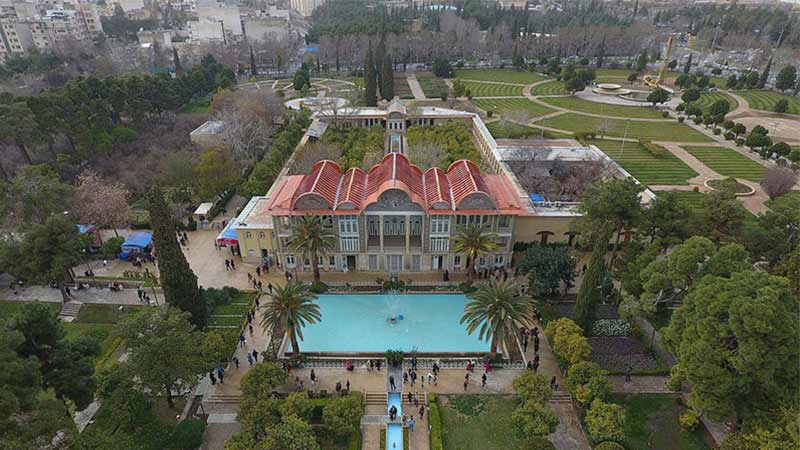
A Lush Park with Various Trees
It’s believed that the garden dates back to the Seljuk era, as Atabak Qarache, the ruler of Fars, built several gardens in Shiraz during this time, possibly including Eram Garden. The garden existed through the periods of the Inju and Muzaffar dynasties and the Gorkanian era, although there is little information except for a verse by Hafez that indicates the Inju family once owned it.
The garden then came under the control of the Muzaffarid sultans. There’s limited information about the garden during the Safavid era, but foreign travelers’ writings mention the prosperity and magnificence of gardens at that time. From the Safavid era onwards, all Iranian gardens, including those in Shiraz, were developed and renovated, including Eram Garden.
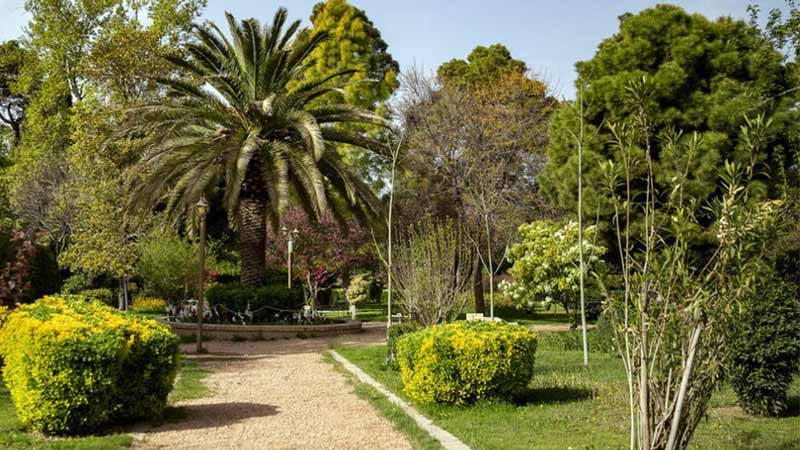
Eram Garden in Shiraz: A Green Oasis
In the late Zand era, the garden was controlled by the leaders of the Qashqai tribe for about 75 years, who used it as their headquarters and built a mansion there. Later, during Naser al-Din Shah’s reign, another mansion’s foundation was laid, taking several years to complete. It’s believed that the main building of the garden existed until Naser al-Din Shah’s era, and when Hajj Nasir al-Mulk Shirazi bought it, he apparently built the current mansion based on the original.
Abolqasem Khan Nasir al-Mulk, his son-in-law and nephew, completed the decoration of the building and some unfinished areas. A marble inscription above the northeast entrance door, written in Nastaliq script, dates back to when Nasir al-Mulk was the governor of Fars during Mozaffar ad-Din Shah Qajar’s reign.
The Building of Eram Garden in Shiraz
Six stone inscriptions can be seen on the eastern façade of the building, with various dates and mentions of Nasir al-Mulk.
Eventually, Eram Garden came into the possession of the wife of the Pahlavi Shah, who then donated it to Shiraz University for use as a guesthouse. Due to natural decay, the garden’s building underwent major renovations between 1966 and 1971, including the construction of a stone wall with iron railings in place of the garden wall, and restoration of various decorations like mirror work and ceiling paintings of rooms and porches. In addition to the garden’s reconstruction, a large piece of land was added to it.
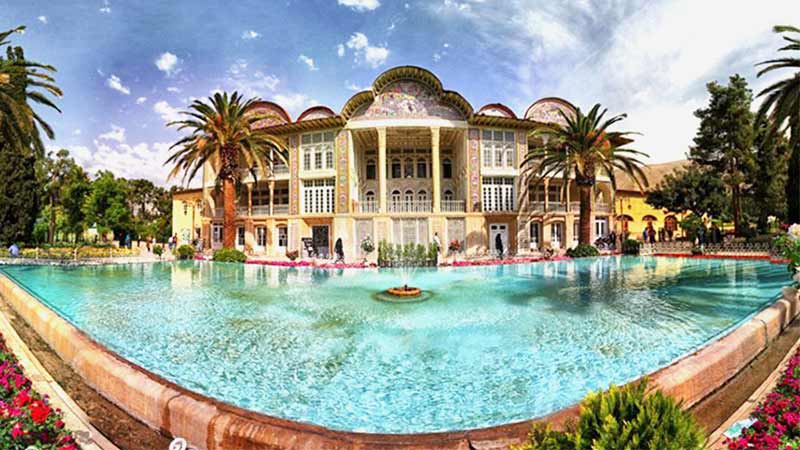
The beautiful and delightful Eram Garden, now owned by Shiraz University, covers about 110,000 square meters and is mostly filled with orange and cypress trees. On July 27, 2011, it was registered as a World Heritage Site by UNESCO.
Where is Eram Garden in Shiraz?
Eram Garden, as one of the main destinations in shiraz tour , is located in Fars Province, on Eram Street, near Eram Square, and close to Shiraz University complex.
Architecture of Eram Garden
Eram Garden features a rectangular layout, originally surrounded by mud walls, now replaced by railings. The architects designed the garden to counteract the natural slope from west to east by incorporating steps in different areas. The main buildings can be found in the western part of the garden, including a primary mansion and interior quarters, interestingly elevated above the rest of the garden’s terrain.
A beautiful pool is situated near the main building, measuring 335 meters in area and half a meter in depth. It’s made of several large stones believed to date back to the era of Jahangir Khan Ilkhan. The depth of the pool was apparently greater in the past but was reduced after restoration. Four elegant palm trees at each corner add to the pool’s charm, and you can see the reflection of the building in the water. When visiting the garden, you’ll notice a stream flowing along this pool, eventually feeding into smaller pools and then into the garden’s waterways.
The main entrances to Eram Garden face north and towards Eram Boulevard, while the other sides are bordered by Asiyab-e Setayi Boulevard, residential houses, and other gardens.
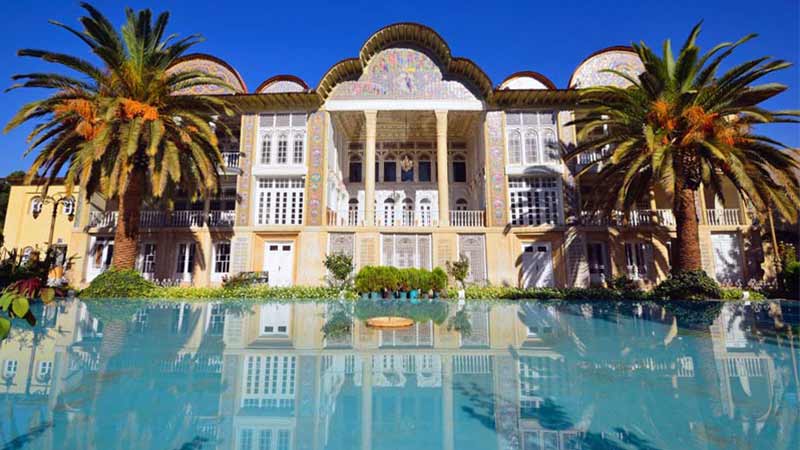
Main Mansion of Eram Garden in Shiraz
The main mansion in the western part of Eram Garden is a major attraction for tourists. The garden is designed so that visitors have to walk its length to reach the center and the main building.
The mansion comprises three floors with a gabled roof, adorned with everything from plasterwork, painting, carving, ornate iron-latticed windows, woodwork, and tilework. This building is a prime example of mid-Qajar era architecture, following the architectural principles of the Zand and Safavid eras. Even the mansion’s doors are beautifully crafted from teak wood, maintaining their original form and remaining intact over the years.
The expansion of the garden and the addition of vast lands to the western part have positioned the main mansion and interior buildings centrally within the garden.
One of the notable attractions within the main mansion is a museum named “Stone and Gem of the Sea of Light,” established in 2011. It showcases over 140 types of precious stones and rare gems from Iran and around the world.
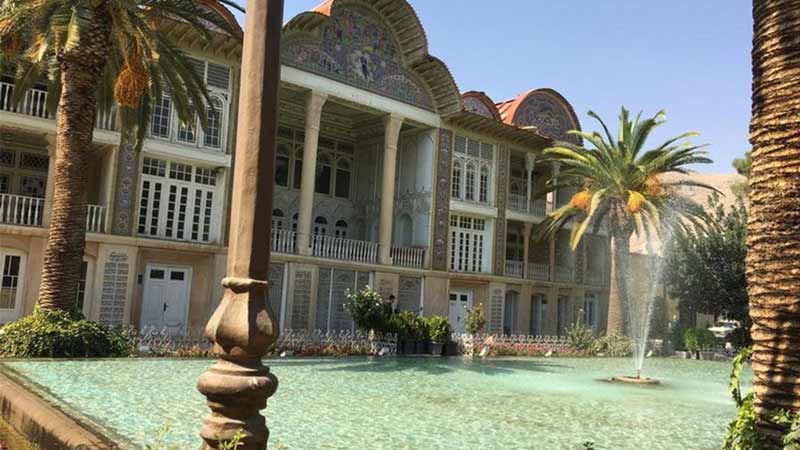
Floors of the Main Mansion
The main mansion of Eram Garden in Shiraz consists of three floors, with the interior currently closed to visitors.
The first floor is known as the “pool house hall,” built at ground level to provide a cool resting place during hot summer days. In addition to a water feature and a stream running through it, a magnificently carved stone pillar stands here. The ceiling and walls are covered with seven-color mosaic tiles, showcasing some of the best examples of Qajar era tilework, with beautiful images of the story of Khosrow and Shirin, hunting scenes, and nature.
The second floor includes various sections like porches, a hall, and corridors. A large porch with a flat, high ceiling and two solid stone columns can be seen here. The columns are adorned with images of men in Qajar clothing and floral motifs. The unique feature of this two-columned porch is the plaster decorations on its three walls and the tilework around its front and sides, distinct from other Qajar era buildings. Additionally, two smaller porches with solid stone columns complete the beauty of this floor. Directly above the kitchen on the first floor and on the south side of this level, there’s another kitchen. Interesting examples of Qajar era windows are also found here, including three iron windows at the entrance to the basement, which have remained since the building’s construction. The central window is larger than the two symmetrical ones on either side.
The third floor features a large hall similar to the one on the second floor, positioned right in the center with windows facing the main porch. Structurally similar to the second floor, it includes three rooms and another large hall. Both halls on this floor have ceilings with wooden beams and exquisite paintings of arabesque patterns, flowers, hunting scenes, women’s faces, and more. These motifs vividly illustrate the ceiling painting art of the Qajar era in Shiraz.
Exterior and Decorations of the Main Mansion
The first thing that captures the eye upon seeing the main mansion of Eram Garden is the seven-color tilework on its facade. The edges of the western facade windows feature patterns of Achaemenid kings and soldiers, flowers, and landscapes. The most stunning part of these decorations is a depiction of Darius the Great and a panther hunting a deer, which never fails to amaze onlookers.
Columns inspired by Persepolis can be seen on two floors of the mansion, evoking the glory and beauty reminiscent of that era. Additionally, two semicircles are present on the top sides of the building, with a panel featuring three crescents in the center of these semicircles, known architecturally as “centaury.”
In the largest crescent, alongside an image of Naser al-Din Shah on a white horse, are depictions of the hero Rostam, Solomon and the Queen of Sheba, Khosrow and Shirin, and Joseph and Zuleika, inspired by stories from Ferdowsi, Nizami, and religious tales.
Other Structures in Eram Garden
Interior Quarters: The interior mansion and its surrounding area consist of two halls and five rooms, located on the west side of the garden, right behind the main building. On the west side of the interior area, a one-story building sits on a higher level than the rest of the interior area. The interior mansion’s front is adorned with a crescent-shaped tilework belonging to the Qajar era, simultaneous with the tilework of the main building. On either side of the central room and under the crescents, there are two brick columns with inlaid tilework.
Pathways of Eram Garden
The central pathway of the garden, one of its most attractive features, is lined with cypress trees on both sides. It’s a favorite spot for tourists to capture the beauty of the garden in their photographs. Among these trees is a towering cypress, over 1000 years old and standing at 35 meters, making it the tallest cypress in Shiraz. At the base of this tree is an imposing old vine, whose branches cover the cypress.
The main pathway runs from west to east, starting from the main mansion and heading towards the end of the garden. This path splits into several branches, each leading to different corners of the garden. To traverse this route, visitors must navigate steps designed to even out the garden’s slope.
Another pathway runs from north to south, intersecting with the main pathway. In addition to these two primary pathways, there are other parallel paths throughout the garden.
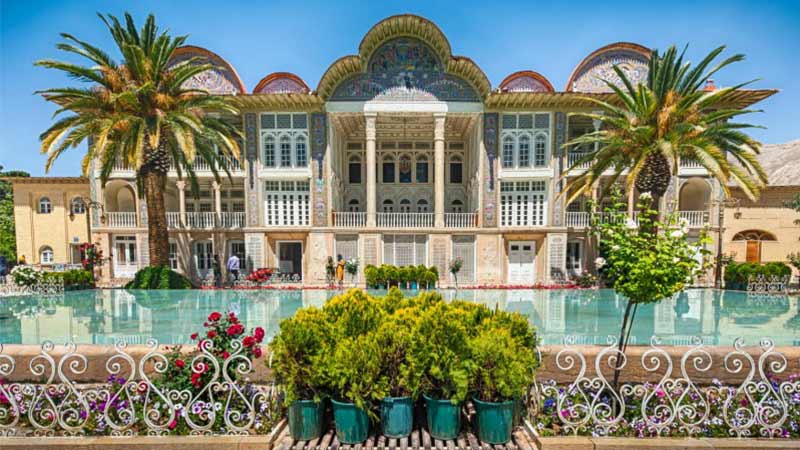
Water Source of Eram Garden
The water circulation in Eram Garden originates from the pool in front of the main mansion. Much of the pool’s water is supplied by the Nahre Azam qanat, the largest water source in Shiraz, used for watering many gardens. Additionally, two wells have been dug in the garden for watering the flowers.
Inscriptions of Eram Garden
The current appearance of Eram Garden dates back to the era of Naser al-Din Shah Qajar. Since it was built by Nasir al-Molk, several stone inscriptions from him remain throughout the garden. At the northeast entrance, multiple inscriptions and tileworks are visible, including one with the verse “Nasr min Allah wa fath qareeb” in Nastaliq script on inlaid tile.
Another inscription is made of lemon-colored marble, starting with “Bismillah al-Rahman al-Rahim” and featuring the verse “From Minister Shah Nasir al-Molk Rad, may Eram Garden be forever prosperous” in Nastaliq script. On both sides of the northeast entrance, two arches feature inscriptions from the Quran.
The inscriptions in Eram Garden in Shiraz are not limited to these and include six stone inscriptions on the eastern facade of the first floor, bearing verses from renowned Iranian poets like Hafez and Saadi. It appears that previously, there were patterns on these six inscriptions, later replaced by verses in Nastaliq script. Two limestone slabs are also located on either side of the pool house, featuring iron windows between them. The image of a man dressed like a southern tribal warrior with a spear in hand is engraved on these slabs, inspired by Achaemenid era patterns from Persepolis.
Vegetation of Eram Garden
The plant diversity in Eram Garden is so extensive that plants from various parts of the world can be seen there. It makes every visitor feel like they are in an exhibition of different kinds of flowers and plants. This variety of plant species and ornamental flowers has led to its use as a botanical garden for educational and research purposes at Shiraz University.
The garden is also rich in decorative plants, especially the rose flowers on the western and northwestern sides, which add a special beauty and freshness to it. The variety of rose flowers in this garden amounts to about 200 species.
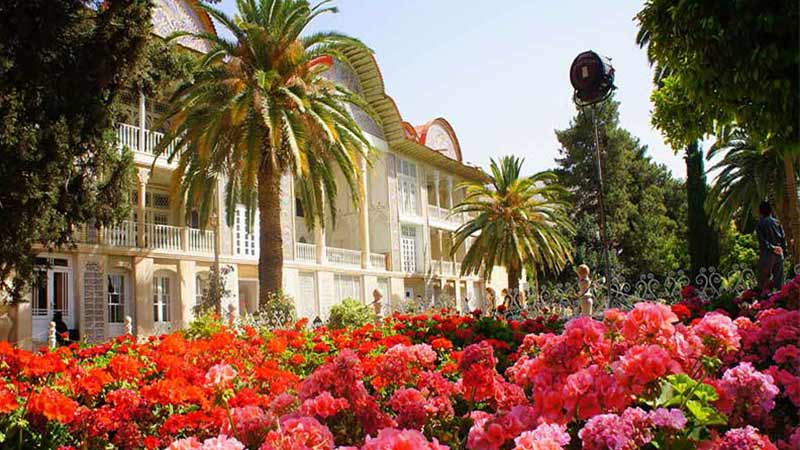
Among the trees in this garden, one can find walnut, almond, apple, persimmon, bitter orange, pomegranate, medlar, and pear trees. Non-fruit bearing trees like pine, eucalyptus, cockspur coral tree, white poplar, graceful cypress, Judas tree, silver tree, crazy willow, and musk willow also greatly enhance the beauty of Eram Garden.
Conclusion
In conclusion, Eram Garden in Shiraz is a stunning blend of history, culture, and natural beauty. With its rich past, lush greenery, and artistic structures, it’s a must-visit for anyone exploring persian culture and traditions. Did you enjoy learning about Eram Garden? If so, we’d love to hear your thoughts or questions in the comments below. Your feedback is always welcome!



